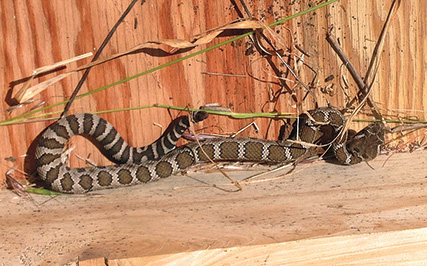Tribal Government & News
Tribal employees find rare rattlesnake at butte

At Rattlesnake Butte Wildlife Refuge just outside of Monroe, the
Grand Ronde Tribe has made a rare, indigenous rattlesnake
find.
A small, female western rattlesnake, the only indigenous
rattlesnake found in Oregon, showed her face on June 12.
"We had placed these tin sheets out to attract them," said Fish and
Wildlife Program Manager Kelly Dirksen, who made the discovery with
Biological Technician Nathan Breece. "The tin sheets draw the
snakes because they provide cover and warm up underneath when the
sun's out. We flipped the tin over and there was the snake.
"We have equipment that we used to safely get our hands on the
snake. We had it for maybe 10 minutes and then released it."
Dirksen and Breece documented the first western rattlesnake the
Tribe has seen at the refuge. Although there is a history of
western rattlesnakes in the area, it has been so long since a
sighting of the northern Pacific subspecies, as this one is
believed to be, that many thought it had gone extinct in western
Oregon, said Breece.
There are only a few pockets in western Oregon where this
rattlesnake has historically existed, said Biologist Lindsay
Belonga.
So, what's become of this first rattlesnake to make it back home?
"Hopefully," said Dirksen, "it is back to making a living at
Rattlesnake Butte."
In 2012, the Bonneville Power Administration and The Nature
Conservancy signed a memorandum of understanding with the Grand
Ronde Tribe, giving the Tribe responsibility to maintain and manage
97-acres in this wildlife refuge.
Since then, members of the Tribal Fish and Wildlife and Ceded Lands
programs have been cataloguing plant and animal populations on a
monthly basis.
The MOU requires the Tribe to forever protect the area for
indigenous wildlife conservation. Maintenance costs come out of a
$157,954 trust fund provided by Bonneville Power and the Tribe
continues to look for other grant opportunities to help with
habitat improvement, said Dirksen.
Tribal employees look through the different habitats for the kind
of indigenous vegetation and reptiles that traditionally lived
there, said Belonga.
The 97 acres of refuge land was purchased by The Nature Conservancy
- 50 acres in the mid-1980s and 47 more in August 2012. Bonneville
Power Administration purchased the land from The Nature Conservancy
to fulfill a small part of its obligation to manage or get another
entity to manage 17,000 acres as a conservation refuge.
BPA's obligation is to return habitat lost to the people of Oregon.
Flooding wiped out habitat when the power agency built dams to
generate affordable electricity for rural areas in the
Northwest.
The Tribe bid for the opportunity to manage the property virtually
forever. The Tribe sought to take on this job because indigenous
peoples already had successfully managed the land for thousands of
years and the Tribe has the expertise to bring the area back. The
property also falls within the Tribe's ceded lands.
In cooperation with the Tribe's Land and Culture Department, the
Natural Resources Department's Fish and Wildlife program is now
collecting biodiversity information about the area.
Dirksen, Breece, Aquatic Biologist Bryan Fendall and Belonga, all
of the Fish and Wildlife program, are participating along with
Hydrosystems Compliance Specialist Lawrence Schwabe from the Ceded
Lands program.
What is left of the indigenous species in the refuge has survived a
battering through the years at the hands of agriculture, rock
quarry operations and urban development.
Other indigenous reptiles in the wildlife refuge include gopher
snake, northwestern garter snake, northern alligator lizard,
western fence lizard and western skink.
Within the 97-acre refuge are south-facing rocks at the
south-western edge of the Willamette Valley. These rocks harbor
hibernating reptiles native to the valley.
Flora documented in the area include rare Lemmon's needlegrass from
the silver moss plant community. Two other rare plant communities
documented on the property are the savanna-type Roemer's fescue and
Oregon white oak savanna. Once widespread in the valley, they now
are limited to a few small areas.
Typical flora in the valley includes prairie and savanna
wildflowers.
Documented but uncommon plant species include Hall's violet,
prairie lupine and turkey mullein.
The Tribe secured a stewardship account from the Bonneville Power
Administration in 2013 to maintain the conservation value of the
property.
The Tribe's final management plan for the area, a requirement of
the BPA, is expected to be completed later this fall, said
Belonga.
In a backgrounder about the new sighting, Dirksen reported that the
Tribe's interest in the few remaining populations of western
rattlesnake have been sparked by references in "oral histories and
myth texts" of the Kalapuya people.
"Now, the Grand Ronde Tribe has a role in maintaining the habitat
of this very rare snake endlessly into the future," he said.
Management of the environment for these snakes "is not easy,"
Dirksen reported, "and the fact that no one else in the valley is
doing it reflects the Tribe's capacity to take on unique and
challenging opportunities."
